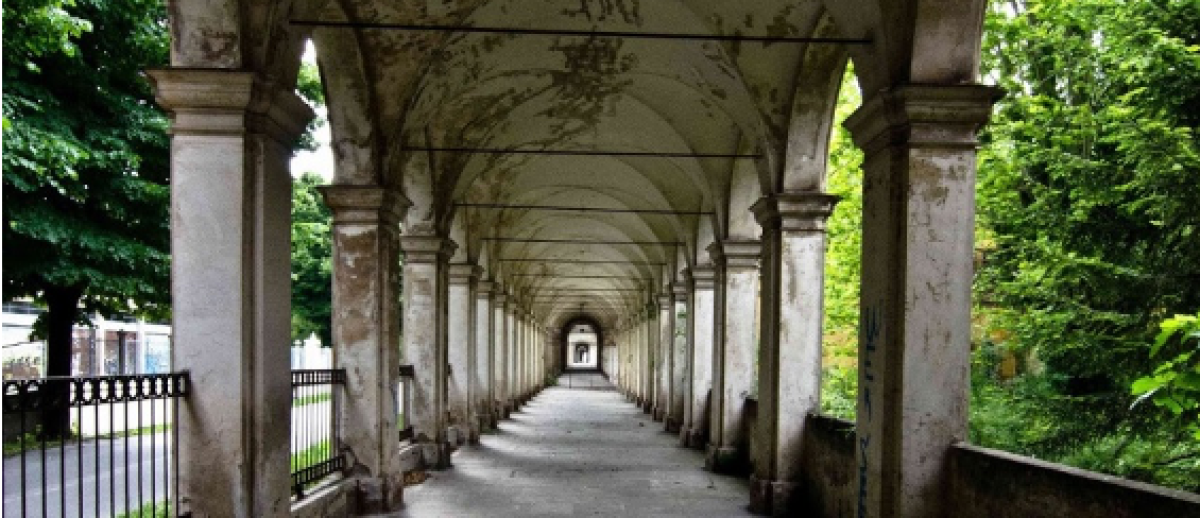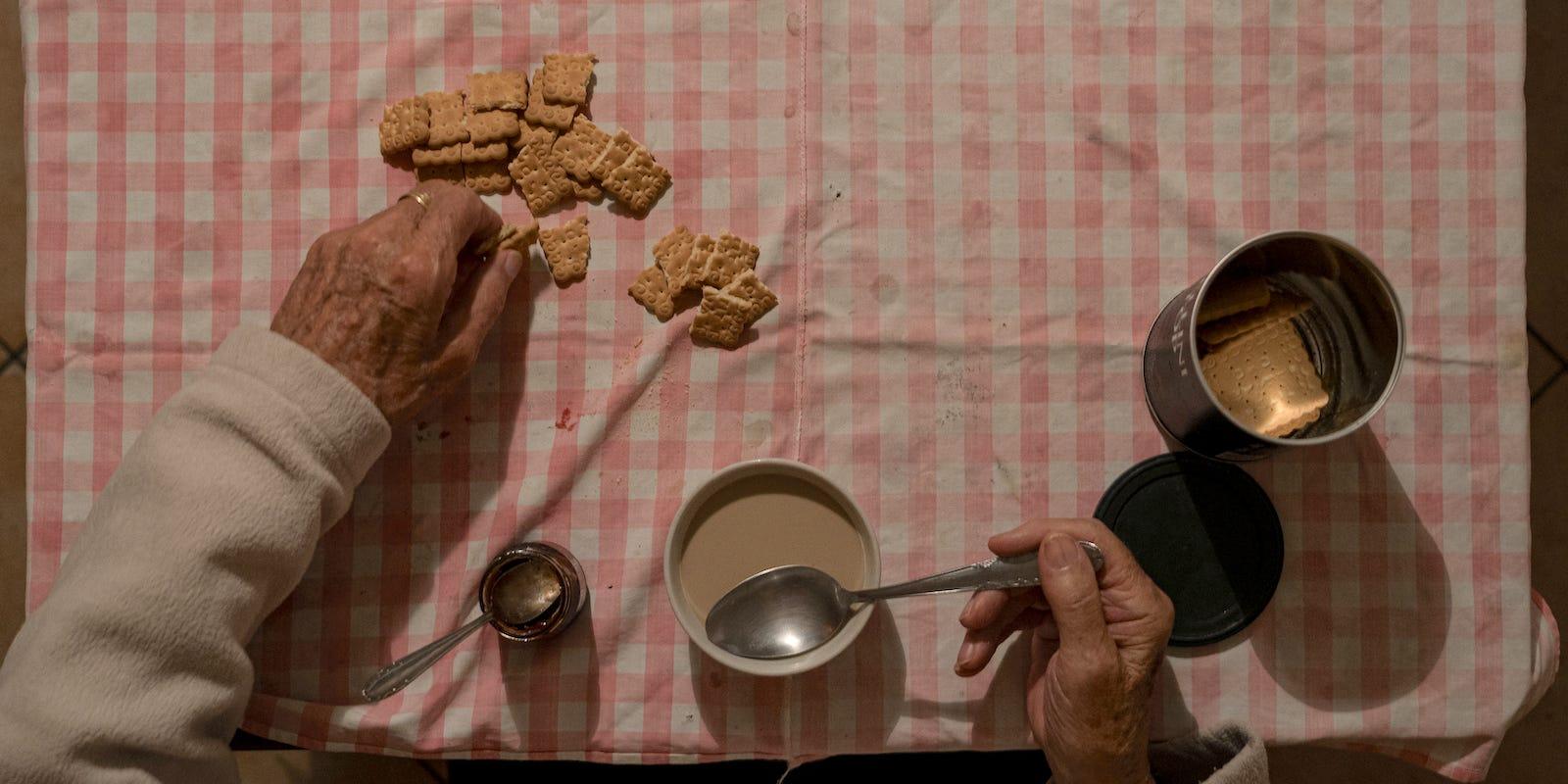On Isolation and the Self: Comparing Covid-19 Policies to Asylums
archive


The Asylum of Collegno near Turin, Italy. (Photo credit: Alessandro Cortazzi Photography)
On Isolation and the Self: Comparing Covid-19 Policies to Asylums
A few kilometers away from my hometown of Rivoli, on the outskirts of Turin in Northern Italy, it is common to pass by the Certosa Park of Collegno. It’s a place for taking a walk, doing sports, or heading to restaurants and cultural associations in the neighborhood. Everyone in the area is familiar with it. The park, however, is also associated with a difficult social, material, and immaterial heritage, linked to memories of a “traumatic past”: it used to be one of the biggest manicomi (asylums, mental hospitals) of Italy from 1852 until 1980 when it was abolished.
In view of the latest global pandemic, confined in my home, I’ve started questioning other people’s experiences of “social isolation.” Feeling trapped within four walls, my thoughts turned to stories I’ve read so often about life in the asylum of Collegno. Very soon I realized that its history could offer insights for exploring the philosophical nature of the concept. Isolation is not only the action of separating oneself from the “other,” but also involves a series of processes reaching from the individual to the collective and legislative. This implies not only considering governmental policies, but also the social impact and consequences of isolation on personal feelings such as solitude, recreation, loneliness, and boredom. According to the American Psychological Association, the phenomenon of isolation can have a negative effect on physical, emotional, and cognitive health,1 in that it “disrupts brain development (in younger members of social species) and leads to mental health problems later in life.”2
This essay reflects on the development of “self” within a situation of “total segregation”3 by comparing the “self-isolation” measures imposed by the COVID-19 context to confinement in a mental hospital. We will see that while there are similarities in terms of the psychological effects of isolation, in fact the two conditions differ by the degree of freedom they afford in socializing with the external world and in regard to consensual participation in the practice.
The Asylum as Total Institution
During the 19th and the early 20th centuries, mental hospitals were very popular in Europe and the US. They developed as institutions for the care of the “insane,” who until that time had been cared for in domestic settings.4 Nowadays, such hospitals are considered to be places where people were deprived of their liberty and delivered without their consent; however, in the past, their role was understood to be that of preserving and controlling psychiatric conditions, based on genetic traits and predispositions.
In his study of psychiatric asylums in 1960, sociologist Ervin Goffman coined the term “total institution” to define the process of progressive transformation of a person’s identity. Once committed to an asylum, individuals are deprived of freedom through isolation and the imposition of daily rituals:
“They are unable to regulate their daily rhythm, are addressed in a standard way, and have little or no contact with the outside world. (…) On long term, the lack of freedom, and the solitary confinement, can have a negative impact on patients’ brain structure related to learning processes, memory, and spatial awareness; moreover, it can also increase fear and anxiety due to a sensory deprivation experience. Other examples of total institutions include monasteries, cadet schools, and army training camps.”5
Together with a program of inmate work duties, a series of other measures were employed to facilitate adherence to an “identity” that was imposed on the institutionalized person: they include the conferral of a reference number that would replace her or his name, and the application of behavioral correction measures—punishments, isolation, leather ties, handcuffs, restraint chairs, straitjackets and protection beds, even electroshock treatments.
For the inmates of Collegno, refusing to adhere to these practices corresponded to an act of resistance that reflected an awareness of the impact that the routines could have on them. As one inmate later declared: “I also tried it [the electroshock] as a punishment, when I refused to work for nothing... everyone in those days refused, because those who worked were perhaps those who lost the hope of getting out of the asylum, they were slaves.”6
Social Isolation's Impact on the "Self"
Today we all experience the condition of “social distancing” and “self-isolation” imposed by the coronavirus pandemic. Yet, how does this global phenomenon impact the individual’s sense of self? Does the practice also involve the same deprivation of personal identity as experienced by asylum inmates? To what extend is today’s “self-isolation” different from other forms of “imposed isolation”?
To answer these questions, it is necessary to look at the literature related to experiences of isolation. Reading the stories of remarkable artists and writers such as Emily Dickinson or Vincent van Gogh, of imaginary or historical heroes such as Robinson Crusoe or Napoleon in exile, and even more, of religious figures retiring in convents and hermitages, we notice that solitude in these examples was induced by various environmental and social factors. While not always determined by the person’s consent, isolation in these narratives tends to focus on the exploration of the self, rather than its deprivation.

Lockdown in San Fiorano, Italy. (Photo: Reuters)
On a philosophical and psychological level, the modern concept of isolation cannot be dissociated from the neoliberal approach of freedom. In Western capitalism, the art of governing is characterized by acts of “responsibilization” and “empowerment” of individual selves, who answer alone for their personal success or failure in society.7 The call for “self-isolation” during the COVID-19 pandemic is a good example of this model of governance. The dominant political system attempts to prevent the overburdening and collapse of public health services by emphasizing the importance of “social distancing” as a participatory response of global solidarity and as a potentially positive source for production of creativity and autonomy.
Current attitudes approach the concept of “solitude” as potentially therapeutic. For example, in an article titled “The Virtues of Isolation” that appeared in the Atlantic in 2017,8 isolation is described as a way of self-reconfiguration by reflecting on “existentializing moments” that occur in times of personal turbulence due to social anxiety and stress. In an interview about the fear of “loneliness” within the coronavirus context, philosopher Lars Svendsen claims that this feeling can be constructive if you choose “to live in a state defined by the absence of others, and if you manage to, strictly speaking, be in your own company.”9
[T]he two conditions differ by the degree of freedom they afford in socializing with the external world and in regard to consensual participation in the practice.
Yet the new policies of “social distancing” also involve the adoption of a series of new rituals and organizations of time (such as working from home, going out wearing facial masks and gloves, maintaining a certain distance in public spaces), generated by the fear of transmission of the virus. Failure to observe these rituals can result in adverse consequences for national economies, for people’s livelihood, for upholding central social institutions, and social stability. Therefore, “remaining at home” is proving to be an extremely problematic and anxious experience for many millions of people around the world.
Furthermore, we must consider the social disparities associated with COVID-19. Anthropologist Didier Fassin10 has shown how the virus disparately affects the most vulnerable in society, such as refugees, prisoners, minority groups, elderly, and disadvantaged people with poor access to a healthcare system, many of whom also face increased discrimination in this time.11
Conclusion
If we look closely at the comparison between “self-isolation” and “imposed isolation,” we can conclude that both forms are characterized by fear, loss of autonomy, and changes in daily practices imposed by a specific institutional protocol. Whatever is the cause of a social isolation, the experience can be so stressful that many psychologists have compared its extreme effects to solitary confinement, a form of torture.
Nevertheless, there are important differences. Foremost is that in the current situation people participate in “social distancing” measures as form of protection imposed by health policies. What most distinguishes “self-isolation” from “total isolation” is consensual participation in the face of a global social and healthcare crisis. Indeed, one may actually feel a sense of commitment to and participation in a transnational crusade against the virus on behalf of humankind. By comparison, inmates of asylums remain outsiders—they cannot be responsible for their own care nor decide their actions.
Finally, we can affirm that the definition of self is a dynamic process, shaped by the socialization with the other. As explained in this article, the deprivation of freedom leads to the alteration of individuals’ identity. However, let’s not forget about the role of social media as agents of socialization that allows “people at home” to remain interconnected and to create communities, networks and space for creation and expression of self.
1. https://www.apa.org/monitor/2019/05/ce-corner-isolation (accessed April 21, 2020)
2. Neuorscientist Dean Burnett in an article for the BBC Science Focus Magazine, in https://quillette.com/2020/04/09/seven-reflections-on-isolation/ (accessed April 21, 2020)
3. In relation to the concept of “total institution,” whereof I will discuss in the article.
4. Suzuki, 1991
5. Goffman, 1961, pp. 7-13
6. Barbero a.a., 1991, p.24
7. Pyysiäinen, Halpin and Guilfoyle, 2017
8. https://www.theatlantic.com/health/archive/2017/03/the-virtues-of-isolation/521100/ (accessed April 20, 2020)
9. https://medium.com/the-philosophers-stone/cabin-fever-the-philosophy-of-isolation-with-lars-svendsen-ee108eafce31 (accessed April 21, 2020)
10. Fassin D, 2007, Fassin D, 2006, Fassin D., 2010
11. Fassin D., 2020
Barbero C., Canuto F., Fischetti F., Morde V., Saltarin L., Serino O., Analogia di percorsi per una nuova uscita, Edizioni Proget, Seria il Margine, 1991, Collegno.
Becker H., Outsiders: Studies in The Sociology Of Deviance, The Free Press, U.S.A., New edition, 1997.
Canedo A., Collina C-S., Ero pazzo, scusa, ero davvero pazzo, Edizioni Gruppo Abele, Torino, 1997.
Contrôleur général des lieux de privation de liberté (CGLPL), Isolation and restreint in mental health institutions, Dalloz Publications, Paris, 2016.
Fassin D., L'illusion dangereuse de l'égalité devant l'épidémie, College de France, Paris, lecture of 16th of April 2020.
Fassin D., Ethics of Survival: A Democratic Approach to the Politics of Life, Didier Fassin Humanity: An International Journal of Human Rights, Humanitarianism, and Development, Volume 1, Number 1, Published by University of Pennsylvania Press, Fall 2010, pp. 81-95
Fassin, D. , Humanitarianism as a Politics of Life, Public Culture vol. 19(3), 2007, pp. 499-520
Fassin, D., La Biopolitique n’est pas une politique de la vie, Special Issue ‘Michel Foucault: Sociologue?’, Sociologie et Sociétés, vol. 38(2), 2006, pp. 35-48.
Foucault M., Histoire de la folie à l’âge classique, Librairie Plon, Paris, 1961 DOI: 10.14375/NP.9782070295821
Goffman, E., Asylums: Essays on the Social Situation of Mental Patients and Other Inmates, Anchor Books, New York, 1961
Harcourt B. E., Rethinking the Carceral through an Institutional Lens: On prisons and asylums in the United States, Champ pénal/Penal field [En ligne], Séminaire du GERN "Longues peines et peines indéfinies. Punir la dangerosité" (2008-2009), mis en ligne le 25 octobre 2009, accessed on April 17, 2020: http://journals.openedition.org/champpenal/7563
Pyysiäinen J., Halpin D., & Guilfoyle A., “Neoliberal governance and ‘responsibilization’ of agents: reassessing the mechanisms of responsibility-shift in neoliberal discursive environments,” Distinktion: Journal of Social Theory, vol. 18 nr. 2, 2017, pp. 215-235, DOI: 10.1080/1600910X.2017.1331858
Suzuki A., “Lunacy, in Seventeenth- and Eighteenth-Century England: Analysis of Quarter Sessions Records Part I,” History of Psychiatry, vol. 2 (8), 1991, pp 437–56, DOI:10.1177/0957154X9100200807. PMID 11612606.
Sitography
George Monbiot, “Neoliberalism promised freedom – instead it delivers stifling control,” The Guardian, 10th of April, 2019 -https://www.theguardian.com/commentisfree/2019/apr/10/neoliberalism-freedom-control-privatisation-state(accessed April 23, 2020)
https://mole24.it/2014/08/25/lex-ospedale-psichiatrico-certosa-collegno (accessed Mai 18, 2017)
torino/https://www.avvenire.it/agora/pagine/collegno (accessed April 3, 2017)



